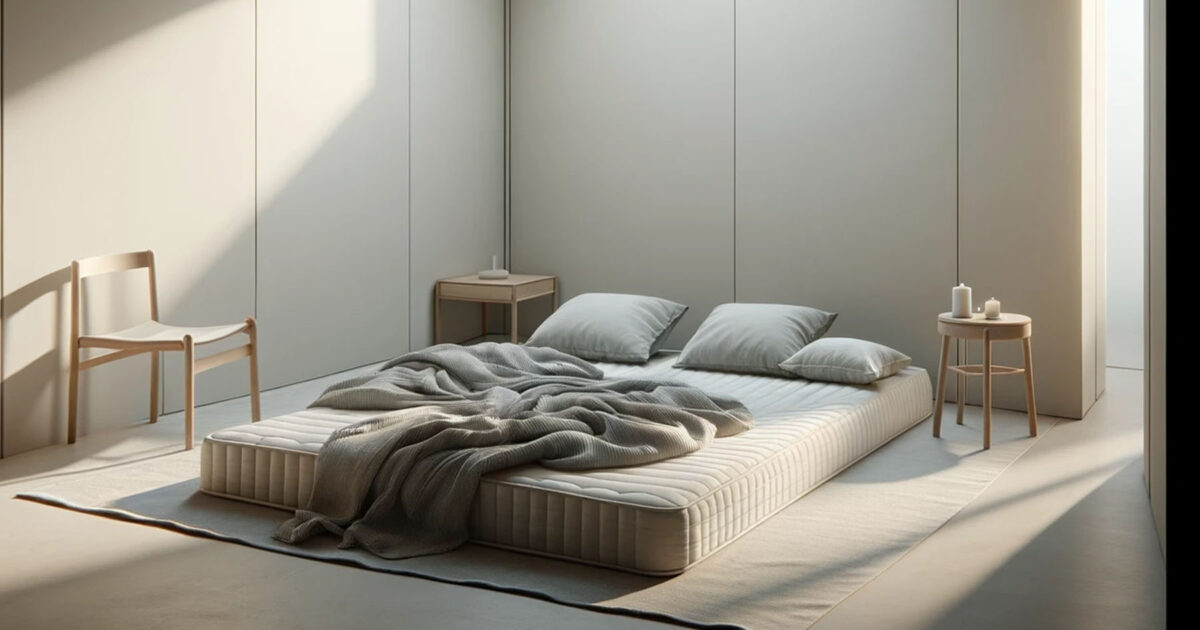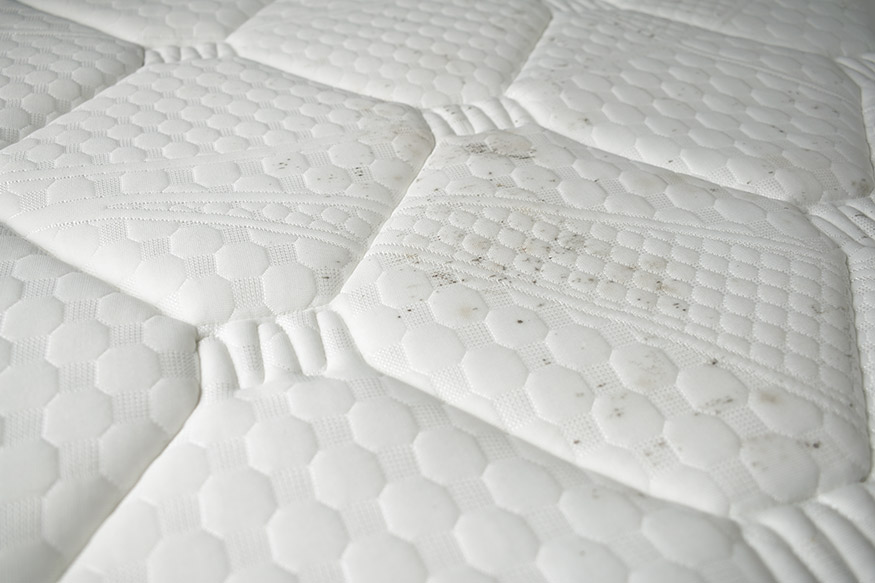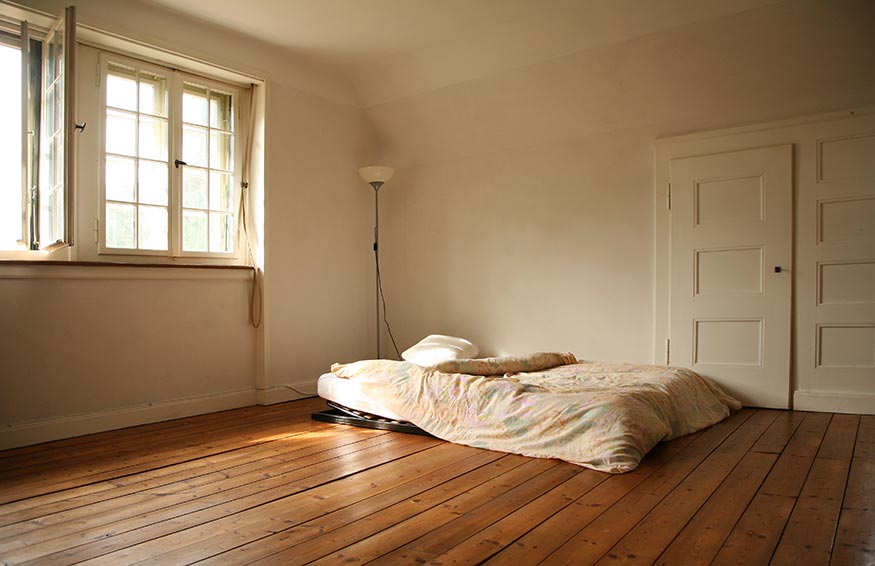Yes you can put a mattress on the floor and there are some benefits to doing so, but you need to consider what the mattress is made of and potential problems that may arise.
In this article, I will go into the pros and cons of placing your mattress and bedding directly on the floor as well as some either tips to keep in mind if you plan to do so.
A Quick Summary:
| Pros | Cons |
|---|---|
| 1. Good support for spinal health | 1. Risk of mold and mildew growth between the floor and the mattress |
| 2. Budget-friendly and long-term savings | 2. Increased exposure to dust and allergens |
| 3. Potential relief from neck and back pain | 3. Reduced airflow under the mattress and comfort issues |
| 4. Improved air circulation for cooler sleep | 4. Mobility and accessibility challenges |
| 5. Space-efficiency and minimalist appeal | 5. Pest accessibility |
| 6. Enhanced blood circulation | 6. Potential warranty issues (may void mattress warranty) |
| 7. Aiding in insomnia management |
Pros of Sleeping with Your Mattress on the Floor

Sleeping with your mattress on the floor can offer an array of benefits, from enhanced spinal support to economical savings and beyond.
The Floor Gives Good Support for Spinal Health and Comfort
The floor provides a perfectly flat and firm surface, ideal for your mattress. This not only helps maintain its shape, preventing sagging, but also ensures optimal support for your spine.
A study assessing sleep quality and comfort in patients with low back pain found significant improvements when using medium-firm mattresses tailored to sleeping positions, suggesting a firm, flat surface like the floor could offer similar benefits .
This can lead to a more restful sleep, minimizing discomfort and maximizing comfort.
Budget-Friendly and Long-Term Savings
One of the most immediate benefits for many people of placing your mattress on the floor is the fact that it saves money. You’re cutting significant expenses by eliminating the need for a bed frame or box spring. A bed frame can cost anywhere from $100 to $1,000 and a box spring or foundation can be $100 – $500, So these are immediate savings.
Sleeping on the floor can also reduce wear and tear on your mattress, potentially extending its lifespan and leading to long-term savings.
Potential Relief from Neck and Back Pain
For those suffering from conditions like sciatica, sleeping on the floor can offer notable relief. According to Brandon Orthopedics, this practice can improve posture and alignment, reduce back and hip pain, and take pressure off the sciatic nerve, potentially easing sciatica-related discomfort.
Many sciatica patients have reported that floor sleeping alleviates chronic pain, possibly due to the reduced soft surface strain on the spine. However, the effectiveness can vary, and different sleeping positions might be needed for optimal comfort.
Improved Air Circulation for Cooler, Fresher Sleep
The floor can enhance air circulation around your mattress, offering a cooler sleeping environment. This improved airflow can regulate body temperature and prevent overheating, contributing to better sleep quality.
Additionally, the increased airflow can prevent heat and moisture buildup in the mattress, keeping it dry and fresh.
Space-Efficiency and Minimalist Appeal
Opting for a floor mattress can transform your bedroom aesthetically and functionally. It creates more room space, especially valuable in smaller rooms, and imparts a minimalist, uncluttered vibe. This approach maximizes vertical space and reduces visual clutter, making even cramped spaces feel more open and airy.
Enhanced Blood Circulation
There are claims that sleeping on a firm surface like the floor can facilitate better blood flow. sites like Sleep Authority and Amerisleep state that blood can circulate more freely and evenly by reducing pressure on any specific body part, nourishing vital organs and tissues.
This improved circulation can bolster various bodily systems, including the immune, digestive, nervous, and muscular systems. It should be noted though that I could not find any scientific studies to support these claims.
Aiding in Insomnia Management
For people with insomnia, a mattress on the floor might be beneficial. This sleeping arrangement can diminish external stimuli and distractions, fostering a quicker transition to sleep and longer, uninterrupted rest.
It can also provide a sense of grounding and security, calming the mind and body and encouraging relaxation.
Cons of Putting Mattresses On The Ground

While placing your mattress directly on the floor might seem convenient and cost-effective, it’s crucial to be aware of the potential drawbacks.
These can range from health concerns to mattress maintenance issues.
Risk of Mold and Mildew Growth Between The Floor and the Mattress
Floor mattresses are vulnerable to mold and mildew due to limited air circulation and accumulated moisture, especially in humid environments. As people tend to sweat during sleep, this moisture can transfer to the mattress, creating a conducive environment for mold and mildew growth.
These organisms can cause a range of health issues, including asthma, breathing problems, and hypersensitivity, particularly in those with compromised immunity.
Additionally, the presence of mold and mildew can significantly shorten the lifespan of a mattress, leading to stains and odors that may be difficult to remove.
Increased Exposure to Dust and Allergens
A mattress on the floor is prone to attracting dust, dirt, and allergens due to its proximity to the ground. This exposure can trigger allergies and respiratory issues, especially if the room is not regularly cleaned. In humid environments, the risk is compounded by the potential for mold growth at the bottom of the mattress, which can further exacerbate allergies and health problems
Reduced Airflow Under The Mattress and Comfort Issues
The lack of sufficient airflow under a floor mattress can affect sleep comfort. Normally, gravity pulls moisture like sweat and shed skin cells towards the bottom of the mattress, but if the mattress is on the floor, this moisture has nowhere to dissipate.
Consequently, it can accumulate within the mattress, forming mold and a warmer, less comfortable sleeping environment.
Mobility and Accessibility Challenges
People with mobility issues may find floor mattresses particularly challenging. The low height can make it more difficult to get in and out of bed, potentially leading to discomfort or increased risk of falls and injuries.
Pest Accessibility

Having your mattress on the floor also makes it more accessible to pests like bed bugs, fleas, and spiders. These pests can easily infest the mattress, leading to damage, unpleasant bites, and potential health hazards. Eradicating these pests can be challenging and might require professional intervention.
Potential Warranty Issues
Using a floor mattress may void its warranty. Many manufacturers require specific types of bed frames or foundations for the mattress to maintain the warranty. Placing the mattress directly on the floor can restrict airflow and lead to moisture accumulation, which are often against the manufacturer’s recommendations. Therefore, it’s crucial to check the warranty terms before deciding to place a mattress on the floor.
Tips for Using a Mattress Directly On The Floor
If you’ve made the choice to place your mattress on the floor, it’s essential to do it right to ensure both comfort and durability.
Paying attention to a few important details can make all the difference.
Choosing the Right Mattress Type
Obviously, you are not going to go out and buy a mattress that is suitable for sleeping on the floor, unless you are planning to stay down there. Nevertheless, there are some mattresses that are more suitable for sleeping on the floor than others.
Look For Mattresses With Open Spaces and Air Movement
A mattress with more open spaces will be better as it won’t trap as much moisture.
Mattresses with open spaces will allow more air to pass between the floor and the mattress, especially if you are resting your mattress on a carpet rather than a concrete floor. Note the open spaces on the mattress in the image below.
Find A Mattress With Inner Springs and Flipping
An innerspring mattress is a good choice simply because it makes it easier for you to get up and the dynamic movement makes it more difficult for things to go stale. Nevertheless, it is advisable that you put a cotton rug or blanket under your mattress, and that you flip your mattress every two days to stop moisture accumulating on the bottom.
Also, look for a thick mattress profile made from durable material – unless you want to feel the hard floor pressing your back.
Memory Foam Mattresses Are Not Built for Floor Sleeping
You probably want to steer clear of memory foam and foam as it tends to trap more moisture. Think of the mattresses with spaces and pockets of air underneath. It is going to collect water, but it will collect it far less efficiently than memory foam.
Memory foam will create an almost watertight seal between the ground and the mattresses. The moisture underneath will not be able to breathe or evaporate, which creates the more dangerous types of mold and fungus that typically damages human health when breathed in.
Maintaining Cleanliness and Preventing Mold
To keep your mattress fresh and mold-free:
- Clean the area with a vacuum and sanitize it weekly to remove dust and potential allergens or mold spores.
- Employ a mattress protector and routinely use fresh sheets to safeguard against spills and pests.
- Let your mattress air out weekly by standing it up, promoting moisture escape and airflow.
- Rotate and flip the mattress periodically to avoid uneven wear and sagging.
- Inspect regularly for mold signs (especially underneath the mattress), like a musty smell or discoloration, and address them promptly.
Lifestyle Considerations

When you opt for placing your mattress directly on the floor, it’s important to think about how it will impact daily life. This choice can influence everything from how you start your morning to the overall look of your bedroom. First, consider the accessibility of your furniture and bedroom essentials.
With a floor mattress, these items may not be as easy to reach, especially if you deal with discomfort in movement. Nightstands and chargers could seem inconveniently out of place.
In terms of aesthetic preferences, going for a mattress on the floor can bring a minimalist vibe to your space. The clean and uncluttered look often aligns with a modern and simple lifestyle. However, remember that others might see this style as overly casual. It’s a way to express personal values like simplicity or even spirituality, as your bedroom’s design reflects your unique taste.
Finally, your comfort and sleep quality are crucial. You might enjoy the firmer base a floor mattress provides, which can be beneficial for back support. But if you are someone who relishes a softer, more cushioned sleep environment, you might not find this setup as cozy. Allergens and dust are also more accessible on the floor, which may affect people with sensitivities.
By considering these lifestyle factors, you’ll create a sleeping space that not only suits your needs but also contributes to a restful night’s sleep for a range of sleepers. It’s about finding the right balance between function, style, and personal well-being.

